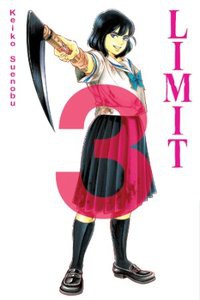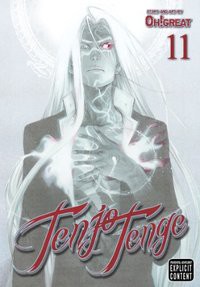RIGHT TURN ONLY!!
BTOOOM! Goes the Dynamite
by Carlo Santos,

I have more thoughts about JManga's closure than can reasonably fit into the space here.
I will say, though, that the way they went out kind of encapsulates the way they did business. Here are the dates that we are closing. You're not allowed to buy anything anymore. You aren't allowed to "keep" any of the manga that you purchased for viewing. And we are not going to ask you how you would like to be credited back your unused points; you are going to get them back via Amazon gift card whether you like it not. Well ... thanks?
I had hoped for them to do well, but given the way they presented themselves, it was as if JManga was purposely doing everything possible to not succeed. If one's idea of customer service is to not listen to the customers ("Can we pay for just the volumes we want? In regular dollars?"), and forcibly push the customers around within an awkward business model, it will not be long before those customers are gone. And so the prophecy fulfills itself.
BOKURANO

Vol. 8
(by Mohiro Kitoh, Viz Media, $12.99)
FROM THE BACK COVER:
"Through battle after battle, the world has known Zearth as an implacable force of destruction. Now, the monster has a human face, as Aiko uses her father's broadcast to deliver a message to the world. An outpouring of support carries the children into Kanji's battle, a test of endurance that may only be won by a drastic, irreversible decision."
EVIDENCE FOR:
With one story arc's poignant finale, and another presented in its entirety, this volume of Bokurano comes loaded with drama. Aiko's moment of glory on live TV proves that even "reality programming" can sometimes be heartfelt (or at least feel like it). The next pilot, Kanji, also brings plenty of serious baggage to his storyline—family issues, life-and-death decisions, and a fragile friendship ... things that Bokurano has already covered, but all concentrated into a single character. The tactics of the next enemy robot also brings variety to the mecha-dueling formula: how are you supposed to defeat it from a distance? Not only that, but the involvement of outside forces leads to a controversial poke at Japanese-American military relations. In the end, though, it's the personal sacrifices and wistful emotions that give Kanji's story its powerful finish. Stark, alien imagery also leaves a strong impression: the unusual construction of the "javelin" robot, the monstrous proportions of Zearth, and the earth-shattering attacks launched by both sides. This kind of artwork strives to present mecha warfare as frightening and saddening, rather than heroic—and in that respect it succeeds.
EVIDENCE AGAINST:
Bokurano is all about what goes on in the head and heart ... because when it comes to surface details, it leaves a lot to be desired. Facial expressions often lack passion or nuance, even when the characters are pouring out their deepest feelings, and the plain white backgrounds during dialogue scenes make it even less enjoyable. Even action scenarios are held back by a bland visual style—there's not much shading or contrast to speak of, aside from the obvious climactic shots. The unconventional robot designs also make hand-to-hand combat hard to follow, as their long, spindly limbs get lost in a flurry of motion. Meanwhile, the story itself goes through some missteps in the middle of Kanji's arc: certain scene-to-scene transitions happen too abruptly (the U.S. launches an attack, and then...?), while other moments get caught up in too much military strategizing. It's as if Mohiro Kitoh was rushing through the details, hoping for an incredible finale—but failed to notice that some of the intermediate plot points don't line up quite right.
FINAL VERDICT:
Between the personal drama, surprising battle scenarios, and a subtle political angle, this segment of Bokurano is rewarding on many levels. Even the middling art doesn't stop this one from getting an A-.
BTOOOM!

Vol. 1
(by Junya Inoue, Yen Press, $11.99)
FROM THE BACK COVER:
"By all counts, Ryouta Sakamoto is a loser when he's not holed up in his room, bombing things into oblivion in his favorite online action RPG. But his very own uneventful life is blown to pieces when he's abducted and taken to an uninhabited island, where he soon learns the hard way that he's being pitted against others just like him in an explosives-riddled death match! How could this be happening? Who's putting them up to this? And why?! The name, not to mention the objective, of this very real survival game is eerily familiar to Ryouta, who has mastered its virtual counterpart—BTOOOM! Can Ryouta still come out on top when he's playing for his life!?"
EVIDENCE FOR:
What if a video game became real life? That may sound like fun, but BTOOOM! turns it around and reveals a more interesting result: disorientation, panic, and all-out violence. Volume 1 kicks off the story with great urgency, moving from the thrills of online gaming, to the fear of waking up in a strange place, to the sheer terror of being chased by a maniac. But there's an intellectual element too: as Ryouta discovers the "rules" of the world around him, he starts to develop a strategy, such that his first kill in the game is actually a smartly planned trap. The discovery of other players on the island, plus flashbacks explaining how Ryouta got there, also show how elaborately constructed this world is—clearly, there's something more sinister at work than just acting out a violent online game. Richly drawn landscapes capture the exotic feel of the battleground, while detailed special effects come to the forefront with explosions, smoke clouds, and showers of debris. Clean, solid linework and close-up angles really make it feel like being there ... just as if it were a video game come to life.
EVIDENCE AGAINST:
BTOOOM! is so focused on the concept that it loses sight of the characters. Take Ryouta, for example, who is basically a stand-in for the slacker-gamer stereotype: jobless, computer-addicted, has unrealistic goals, disrespects his parents. Those traits could define anyone, and it says nothing about Ryouta's individuality or how he relates with others. Then again, when the other folks on the island are also stereotypes—murderous thug, busty schoolgirl, and wimpy salaryman—it's not like he can do a whole lot of relating anyway. Aside from weak characterization, this first volume also jumps around too much in trying to set up the premise: several flashbacks interrupt the main story, explaining how Ryouta lived his life at home, and how he got to the island. Such is the price of a fast-paced start: you have to backtrack eventually, filling in the plot gaps with more mundane content. The artwork has shaky moments too, with character designs sometimes looking inconsistent and too many gray tones dominating the page. A lack of panel variety also hurts—even the most dramatic scenes seem stuck on mid-sized, rectangular layouts.
FINAL VERDICT:
It puts forth some promising ideas, but clumsy storytelling and artistic flaws mean that this series registers a C+ for Volume 1.
LIMIT

Vol. 3
(by Keiko Suenobu, Vertical, $10.95)
FROM THE BACK COVER:
"Immediately after their accident, Arisa Morishige took command of the remaining survivors by exerting her will while clinging desperately to whatever make-shift weaponry was around. Now without her sickle, the dynamic within the party has changed again. The 'slaves' have risen, and one has escaped her watch. And when they discover another survivor, their collective tone evolves once again. Will this old face bring them hope? Or will it completely drive them apart?"
EVIDENCE FOR:
Volume 3 of Limit brings in several new twists that keep the "five girls trapped in the woods" formula from getting stale. For starters, a new character shows up—one whose presence seems to improve the mood, but also causes unexpected tension. A force of good, or a force of chaos? This uncertainty gives the story its addictive hook. New discoveries also add intrigue—what if a certain land feature, like a rope bridge or a clearing, may be the key to getting rescued? But the most riveting thing in this volume is clearly Morishige's character arc: after losing her only source of power (the scythe), this victim-turned-bully loses her sanity too, and the consequences, which emerge in the last few pages, are decidedly shocking. Harsh, sinister-looking artwork drives the point home, with thin, scratchy lines layered atop each other and plenty of dark, shaded areas. Yet the series is just as capable of soft lighting and delicate penstrokes when the characters share a rare moment of peace, and it's that huge visual contrast that makes the ups and downs of Limit all the more effective.
EVIDENCE AGAINST:
How is it that Limit's most interesting personality is also its most unrealistic? Morishige's exaggerated attitude quickly ruins the nuances of her character. She grimaces and cackles at everything, mutters judgemental accusations, and basically acts more like a campy action-show villain than a troubled teen. When the story does try to explain why she's so troubled, we get a cop-out flashback that's been used in many other melodramas to make people feel sorry for unfortunate children. The newcomer is also a study in cardboard characters, but this time in the opposite direction: someone so saintly, it's hard to believe such a person could exist. Even the rescue team behaves unrealistically, acting weak-willed and incompetent so that the kids stay stuck out there, prolonging the story. Layouts could use improvement too, with some pages that look more like a messy collection of panels than a sequence of images. The art also seems to be skimping out on backgrounds more than usual, failing to take advantage of the wilderness setting.
FINAL VERDICT:
Morishige may not exactly be a complex, nuanced villain, but her actions are so compelling—and the last scene so terrifying—that the events of this volume still earn a B.
MAYO CHIKI!

Vol. 2
(by Hajime Asano and NEET, Seven Seas, $12.99)
FROM THE BACK COVER:
"Golden Week has arrived, but there's never a moment's rest for poor Sakamachi Kinjiro. The cross-dressing butler Konoe has been throw out of her home and begs Kinjiro and begs Kinjiro to let her move in. Worse, her ball-busting mistress Suzutsuki Kanade declares she's moving in too!
With everyone crammed under one roof—including Kinjiro's bossy kid sister—the shenanigans begin. To repay Kinjiro, Kanade insists on becoming his maid, while Konoe wants to be his butler! An epic butler vs. maid contest ensues, with Kinjiro and his sister as unsuspecting judges.
All of this, of course, is just another one of Kanade's sadistic ploys to manipulate Kinjiro to do her bidding. What's a guy like Kinjiro to do, as he suffers from an incurable phobia of women, while surrounded by hot chicks whose goal in life is to torture his hapless soul?"
EVIDENCE FOR:
What a difference a new character makes. The current cast of weirdos in Mayo Chiki! is amusing enough in itself, but the emergence of newcomer Usami halfway through this volume is a real shakeup. Even her first appearance comes with great fanfare: riding atop a motor scooter, chewing on a piece of toast, and crashing into Kinjiro from around the corner. It only gets crazier from there, as Usami isn't afraid to inflict bodily harm on the poor boy, and she clearly doesn't mind twisting him into her evil little schemes. Still, the ongoing circus between Kinjiro, Kanade and Konoe continues to be the core of this series—the two girls taking over his house, and Konoe's misguided efforts to get close to him, all lead to plenty of amusing embarrassments. Attractive character designs are another strong point, with fanservice moments that are just enough to grab attention but don't get in the way of comedic action. (Kinjiro has the worst luck with showers and dressing rooms, it seems...) The straightforward paneling also helps move the story along smoothly.
EVIDENCE AGAINST:
Although Mayo Chiki! tries its best at comedy through humiliation, it keeps on picking scenarios that are already totally played out in the genre. Maid versus butler contests? Showers and dressing rooms? That doesn't even take an ounce of creative thought; everyone knows you can get an automatic laugh out of an awkward teenage boy gazing upon a half-dressed girl. And speaking of male gazing, those half-dressed moments are the only time the artwork steps up its game—the rest of the time it's as bland as can be, with generic school and home settings and standard character poses. Just draw their faces and figures, show them talking to each other, and apparently we're done. This volume also lags behind the first on serious character development: there are no heart-to-heart moments like last time, just a lot of jabbing at Kinjiro to see how much he can stand to be around pretty girls. Kanade shares a special moment with him, but it's superficial at best. Usami does take the story in a new direction, but it's a direction that treats the characters as pawns in an over-hyped love polygon—no real emotions, just flirtation and gossip.
FINAL VERDICT:
Usami practically saves this one from getting an even worse grade than it does. Bland art, a shallow storyline, and uncreative comedy situations get a C- overall.
TENJO TENGE

Vol. 11
(by Oh!great, Viz Media, $17.99)
FROM THE BACK COVER:
"The ancient struggle of the gods comes to an epic conclusion as Susano-o is reborn and the sun goddess Amaterasu awakens within Maya. What does Mitsuomi stand to gain by facing down Susano-o? How will Masataka endure his greatest challenge? As Soichiro absorbs tremendous amounts of ki, what role will he play in this last great fight? And can Maya withstand the agony of her transformation and see her friends through to the end of the battle? All fates will be revealed in this final volume of Tenjo Tenge!"
EVIDENCE FOR:
Tenjo Tenge wraps everything up in satisfying fashion, making sure that fans get one last mind-blowing fight, all the major characters are accounted for, and the balance of supernatural power is restored. But even as it hurtles toward the inevitable, the plot manages a few surprises. Mitsuomi and Nagi's confrontation atop the Takayanagi building ends with a mysterious (rather than decisive) result, immortal übervillain Sohaku isn't quite finished with his business, and a friend's heartbreaking sacrifice at the end suggests that the series is about more than just "wanting to be stronger." Indeed, the closing chapters are full of dramatic statements about fate and friendship, while an unexpected Tekken parody even adds a touch of comedy. Still, the true highlight of Tenjo Tenge is the art, which once again dazzles at every turn. Dense speedlines and tilted angles capture the intensity of physical fighting styles, while dramatic shading and surreal effects lend themselves to supernatural techniques. Big, page-spanning panels transform each battle into a true spectacle, while the sure-handed character designs make everyone look as heroic, fearsome, and beautiful as they've ever been. What a great way to go out.
EVIDENCE AGAINST:
The more Tenjo Tenge digs into its centuries-long, crisscrossing back-story, the more confusing it becomes. Not even the final arc can fix that—in fact, it gets worse as flashbacks start popping up everywhere in an attempt to resolve plotlines from the past as well as the present. At one point there's even a flash forward, five years into the future, for no other reason than ... because they could. Who knows? Equally confounding is when the last several chapters suddenly develop Lord of the Rings syndrome, reaching an "ending" about four different times with epilogue after epilogue. Some of it ties up loose ends, but a lot of it is just fluff—a supporting character stepping in to offer some poetic but meaningless parting words. The series may have deep and dramatic things to say about fate, conflict, and humanity versus the gods, but it doesn't arrange those thoughts well. Even the artwork, which strives to be as beautiful as possible, sometimes backfires on itself: the supernaturally-driven fight scenes get lost in their own flashiness, with blasts of ki and exploding walls obscuring the action.
FINAL VERDICT:
Not the greatest, but good enough. The plot sometimes gets clouded by its own sense of self-importance, but spectacular fight scenes and a satisfying finish earn it a B-.

BEAUTIFUL CREATURES

(by Kami Garcia and Margaret Stohl, art by Cassandra Jean, Yen Press, $16.99)
FROM THE BACK COVER:
"Ethan Wate, who has been counting the months until he can escape from Gatlin, is haunted by dreams of a beautiful girl he has never met. When Lena Duchannes—a girl unlike anyone Jackson High has ever seen—moves into the town's oldest and most infamous plantation, Ethan is inexplicably drawn to her and determined to unocver the connection between them.
In a town with no surprises, one secret could change everything."
EVIDENCE FOR:
There is the "teen paranormal romance" fad, and then there is Beautiful Creatures, a story with enough gravitas that it feels like it was carved out from an ancient fairy tale. The secret to the book's success lies in the way it draws from rich cultural sources—the American South, centuries-old witchcraft, and good old folklorical monsters. The supernatural aspect also succeeds because it chooses subtlety over spectacle: mind-reading, time-traveling visions, and prophetic dreams all play key roles, rather than just blowing things up (although some of that happens too). The story's doomsday-countdown format also keeps the tension alive in the middle chapters, where other tales sometimes find themselves stuck for ideas. And tying it all together is the Big Idea: are good and evil predetermined, or can we be agents of our own fate? The sketchy, hand-drawn art gives each page an edgy vibe, similar to the free-flowing style of Natsume Ono but with a more Baroque, fantasy/horror touch. Varied panel layouts and dramatic angles lend plenty of energy to the story's pivotal scenes, especially in the finale where swirls of magical power take over. Simply put, it's haunting ... in a literary and visual sense.
EVIDENCE AGAINST:
Beautiful Creatures has no problem making the paranormal aspect work, but it struggles in trying to fit in the romance. Ethan and Lena's existence as a couple is probably the least-developed element of the story—they seem to get together "just because," and the reasoning behind it is patched in later. Pacing is a problem too, with some segments jumping ahead before the previous plot point is truly, satisfyingly tied up. (The winter ball, for example, just happens and then that's it. What the...?) But that's often what happens when trying to squeeze a prose novel into a single graphic novel. These challenges also lead to a bloated final battle, trying to dish out tons of visual fireworks and running overly long as a result. The hand-drawn art also lacks polish—backgrounds and inanimate objects would have benefited from a ruler, or even better, a technical assistant who could draw cars and furniture accurately. Even some of the shading and effects look hastily scribbled in, and the last thing anyone wants for a beautiful work like this is for it to look like a rush job.
FINAL VERDICT:
It could use some tidying-up in both art and story planning, but Beautiful Creatures still features enough drama and sorcery to please fans of the supernatural.

Change is in the air! With the state of translated manga going through such upheaval the last few years, we now turn to the wistful memories of days gone by. If it's out of print, if the license was dropped, if the publisher went out of business, if the last few copies are languishing in the back corner of a bookstore ... then it's probably here, as you take a stroll down Memory Lane.
MARMALADE BOY

(by Wataru Yoshizumi, Tokyopop)
For fans of a certain generation, Marmalade Boy is just one of those series. You know, a game-changer. It came out as one of the flagship titles in Tokyopop's "100% authentic manga" initiative, when publishing right-to-left was a new thing (hard to imagine, I know). But more importantly, most shojo manga back then came dressed up in action-adventure trappings—Sailor Moon, Magic Knight Rayearth, a primordial translation of Cardcaptor Sakura. But Marmalade Boy was ... regular high school kids living a regular everyday life? But with ten times the drama? Mind-blowing.
As expected, the plot goes through the usual convolutions of an improbable teen melodrama. Miki Koishikawa is a high school girl whose parents suddenly spouse-swap with their old college friends, and as part of the deal, she inherits an attractive stepbrother, Yuu Matsuura. Yuu's personality is sweet, but with a bitter edge sometimes—just like marmalade, hence the title. For eight volumes, the two of them are blown in every direction by the winds of romance, as they try to make sense of whether they like each other or not. Schoolmates and rivals pop in and out as bumps in the road, not to mention the possibility that, through a quirk of family history, Yuu and Miki might be ... blood-related?!
But here's the thing: Marmalade Boy is perfectly designed to maximize the potential for reader addiction. It runs through every possible up and down in a romantic relationship, while dropping cliffhangers in all the right places. The characters are all endearing in some way, with good intentions and embarrassing flaws just like one's own school peers. Wataru Yoshizumi's art is also accessible to fans of every taste—not too wispy and elaborate, not too bold and exaggerated—just the right blend of crisp lines, clear layouts, and comedic touches to please the eye. Now that I've read dozens of other romantic series, I realize this one is pretty much middle-of-the-road. But it does all that middle-of-the-road stuff right—and sometimes, that's all it takes for one series to take up a special space in one's heart.
discuss this in the forum (5 posts) |